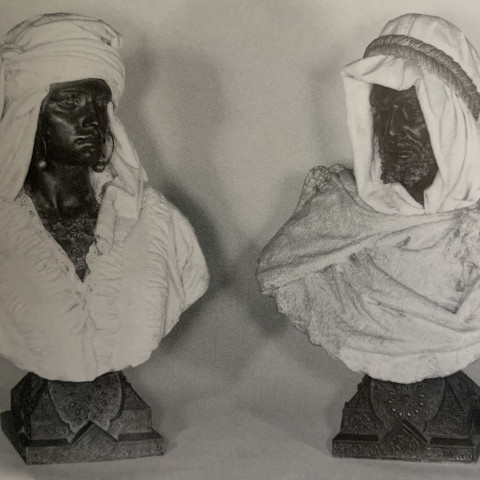Pietro Calvi was born in Milan in 1833 and studied at the Milan Academy. He was an eminent ethnographic sculptor whose work reflected a fascination with the Orient. He later went on to study under the renowned sculptor Giovanni Seleroni. It was under Seleroni’s guidance that Calvi developed the outstanding sensitivity and refinement that became the hallmark of his modelling. Calvi relished working in bronze and marble, often combining the two materials to create the most striking and effective results. His harmonious integration of materials recalls the work of the distinguished French 19th-century ethnographic sculptor Charles Cordier, but rather than treating his subjects with scientific precision, Calvi saw the dramatic potential of his North African sitters. Many of his works were exhibited throughout Europe and America, most notably at London’s Royal Academy between 1872 and 1883 (the year prior to the sculptor’s death).
Works exhibited at the Royal Academy included Selika and Othello in 1872, Lucifer in 1879 and Ariadne the following year (both marble statuettes), Uncle Tom, also exhibited in 1880 and three years later a Minstrel curiously entitled Oh Goodness Gracious Me! Calvi’s works were a great success, and several were repeated on occasion in order to meet the demand for them.
Calvi specialised in subjects from the arts, including several Shakespearean characters, his most well-known being this powerful marble and bronze bust of Othello. Othello is amongst his early groundbreaking models and was one of the first in which he combined bronze and marble.
Other works taken from literature include busts of Ophelia, Hamlet, the Moor of Venice, Graziella, Zuleica and Aida, often being made from bronze and marble, sometimes with gilding. Pietro Calvi worked together with another Milanese sculptor, Constantino Corti, on numerous figures in Milan’s dominating cathedral including a statue of St Valeria which is positioned in one of the side windows, next to a figure by Giuseppe Grandi. He also sculpted works in the Galleria Vittorio Emanuelle nearby.
The sculptor died in his native Milan in 1884.
Sources:
www.bowmansculpture.com
www.askart.com

